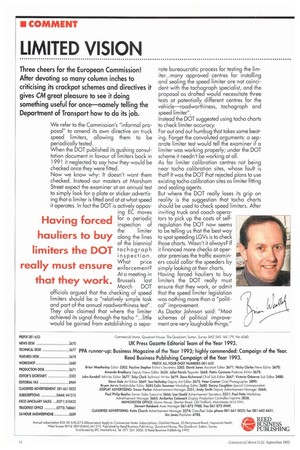LIMITED VISION
Page 16

If you've noticed an error in this article please click here to report it so we can fix it.
We refer to the Commission's "informal proposal" to amend its own directive on truck speed limiters, allowing them to be periodically tested. When the DOT published its gushing consultation document in favour of limiters back in 1 991 it neglected to say how they would be checked once they were fitted. Now we know why: It doesn't want them checked. Instead our masters at Marsham Street expect the examiner at an annual test to simply look for a plate or sticker advertising that a limiter is fitted and at at what speed it operates. In fact the DOT is actively oppos ing EC moves for a periodic inspection of the limiter along the lines of the biennial tachograph inspection. What price enforcement? At o meeting in Brussels last March DOT officials argued that the checking of speed limiters should be a "relatively simple task and part of the annual roadworthiness test". They also claimed that where the limiter achieved its signal through the tacho "_little would be gained from establishing a sepa rate bureaucratic process for testing the limiter_ many approved centres for installing and sealing the speed limiter are not coincident with the tachograph specialist, and the proposal as drafted would necessitate three tests at potentially different centres for the vehicle—roadworthiness, tachograph and speed limiter'. Instead the DOT suggested using tacho charts to check limiter accuracy. For out and out humbug that takes some beating. Forget the convoluted arguments: a separate limiter test would tell the examiner if a limiter was working properly; under the DOT scheme it needn't be working at all. As for limiter calibration centres not being near tacho calibration sites, whose fault is that? It was the DOT that rejected plans to use existing tacho calibration sites as limiter fitting and sealing agents. But where the DOT really loses its grip on reality is the suggestion that tacho charts should be used to check speed limiters. After inviting truck and coach operators to pick up the costs of selfregulation the DOT now seems to be telling us that the best way to spot speeding LGVs is to check those charts. Wasn't it always? If it financed more checks at operator premises the traffic examiners could collar the speeders by simply looking at their charts. Having forced hauliers to buy limiters the DOT really must ensure that they work, or admit that the speed limiter legislation was nothing more than a "political" improvement. As Doctor Johnson said: "Most schemes of political improvement are very laughable things."


























































































